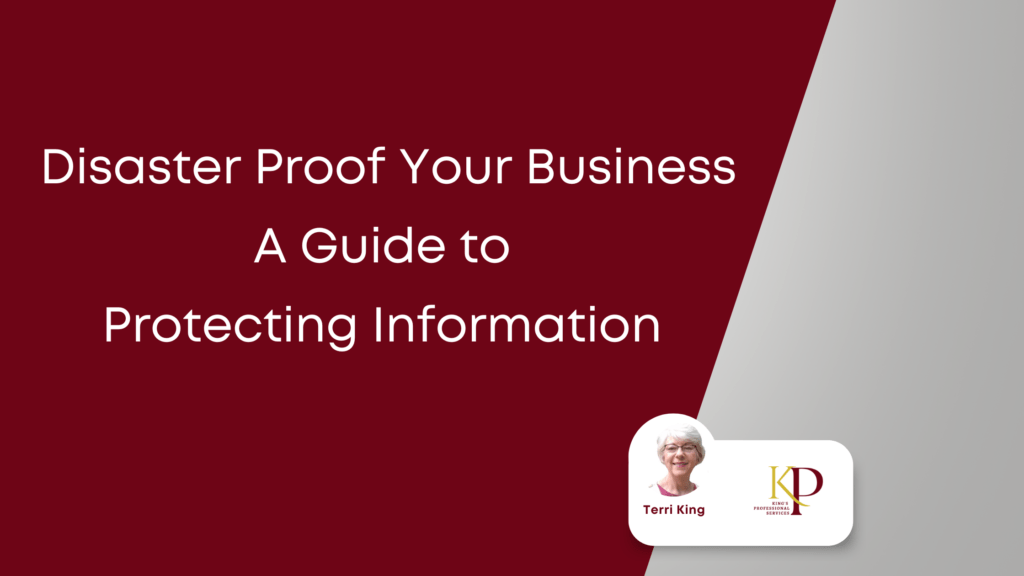Sharing is caring!
My client called to tell me that all – and I mean all – of his business documents had been destroyed in a fire.
“Surely you have backups.”
“Nope, nothing at all.”
He wanted to know what to do now.
This is not a situation any business owner wants to find themselves in.
Disasters are unpredictable.
Research shows that 1 in 10 small businesses suffer losses from a natural disaster; with only 54% of small businesses taking appropriate steps to mitigate losses from a disaster.
Natural disasters strike unexpectedly, wreaking havoc on homes, businesses, and communities. In the midst of chaos, safeguarding critical information becomes paramount to ensure continuity and recovery.
Download my Disaster Preparedness Checklist today.
Let’s explore practical strategies to protect your data and documents when any type of disaster occurs.
Understanding the Risks
Natural disasters come in various forms, from hurricanes and floods to earthquakes and wildfires. Each poses unique threats to information integrity. Imagine losing vital business records to a flood or essential medical documents to a fire. The repercussions could be devastating. Understanding these risks is the first step towards effective preparation.
Preparation is Key
Preparation is the cornerstone of disaster resilience. Develop a comprehensive disaster preparedness plan that includes provisions for safeguarding information. Regularly back up data and store it securely in multiple locations. Cloud storage offers a convenient and reliable solution for remote access to critical information.
Choosing the Right Storage Solutions
When it comes to storage, one size does not fit all. Explore different options such as cloud storage, external hard drives, and offline backups. Consider the sensitivity and volume of your data, as well as your budget and accessibility needs. Each option has its pros and cons, so choose wisely.
Securing Physical Documents
In an increasingly digital world, physical documents still hold significant value. Protect important papers from damage by storing them in waterproof containers and fireproof safes. These simple measures can prevent irreparable loss during disasters.
Creating Digital Copies
Digitizing documents offers numerous benefits, including easier storage, access, and sharing. Invest in reliable tools and software for scanning and digitizing your records. Be sure to organize digital copies systematically for quick retrieval when needed.
Ensuring Remote Access
Establishing remote access to critical information is vital for business continuity during emergencies. Utilize secure remote access solutions to enable employees to retrieve data from anywhere, anytime. This ensures seamless operations even when physical access is restricted.
Emergency Communication Channels
Effective communication is essential during crises. Establish clear channels for accessing and sharing information among team members. Cloud-based collaboration tools facilitate real-time communication and collaboration, fostering resilience in the face of adversity.
Educating Employees
Your employees are your first line of defense against information loss. Educate them on information security protocols and disaster response procedures. Conduct regular drills and simulations to ensure they are prepared to act swiftly and decisively when disaster strikes.
Regular Updates and Maintenance
Disaster preparedness is an ongoing process, not a one-time event. Regularly update and test your disaster preparedness plan to adapt to evolving threats and technologies. Conduct maintenance checks on storage solutions to ensure they are operational when needed most.
Community Resources and Support
In times of crisis, communities come together to support one another. Tap into local resources and collaborate with authorities and relief organizations to enhance your disaster preparedness efforts.
Case Studies
Real-life examples illustrate the importance of proactive information safeguarding. Learn from organizations that successfully navigated natural disasters with minimal disruption. Their stories offer valuable insights and inspiration for your own disaster preparedness journey.
Each week we read about a natural disaster in some area of the world. Safeguarding information during natural disasters is not just a precaution—it’s a necessity. By understanding the risks, preparing effectively, and implementing practical strategies, you can protect your data and documents from the destructive forces of nature.
Take action today to ensure a more resilient tomorrow.
FAQs
1. How often should I back up my data?
Regularly back up your data, ideally on a daily or weekly basis, depending on your organization’s needs and the frequency of data changes.
2. What should I do if I lose access to my primary data storage location?
Having multiple backup locations ensures redundancy. If you lose access to one, you can retrieve data from another location without interruption.
3. Are cloud storage solutions secure?
Cloud storage providers implement robust security measures to protect data. However, it’s essential to choose reputable providers and implement additional encryption and access controls for added security.
4. How can I ensure my employees are prepared for disasters?
Conduct regular training sessions and drills to educate employees about disaster preparedness protocols and ensure they know how to respond effectively in emergencies.
5. What should I do if I discover damage to physical documents after a disaster?
Document the damage and prioritize salvaging efforts. Consult with restoration professionals as soon as possible to minimize further deterioration and loss.
To help you avoid losing critical information in the event of a disaster, download your complimentary copy of my Disaster Preparedness Checklist today.

